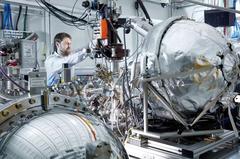The PETRA III synchrotron radiation source offers excellent conditions for many research disciplines. Photo: DESY, Heiner Müller-Elsner
As part of the German Excellence Initiative, the University of Hamburg has been awarded four clusters of excellence and the Hamburg University of Technology one. This was announced by the German Research Foundation (DFG) at a press conference today. The DESY research center is involved in four of these Hamburg-based clusters of excellence, which will be funded from 2026; other non-university research institutions also have a significant share in the clusters.
Prof. Beate Heinemann, Chairwoman of the DESY Board of Directors, congratulates: “I warmly congratulate the University of Hamburg and the Hamburg University of Technology on winning the Clusters of Excellence. This decision is important for the entire metropolitan region, as cutting-edge science is essential for the economy and society in today's world. DESY is involved in a total of four of the Hamburg Clusters of Excellence. This shows the key role DESY plays in research excellence with its outstanding scientists and its large and powerful research facilities.”
Today's decision by the German Research Foundation (DFG) and the members of the international panel of experts appointed by the Joint Science Conference of the Federal and State Governments (GWK) in Bonn will strengthen highly promising fields of research in Hamburg. The Clusters of Excellence, which will each receive up to ten million euros in funding per year from 2026, will address topics such as the function of atoms and molecules in materials, research into sustainable materials that develop completely new properties through interaction or contact with water, ancient writings across cultures and unanswered questions about the universe. Research infrastructures such as the high-brilliance X-ray sources PETRA III or FLASH are irreplaceable tools for many of these questions.
"Our particle accelerators are super microscopes. They allow a unique view into the world of the microcosm, which is valuable for a huge range of research disciplines,” says Heinemann. “With our future project PETRA IV, we are currently planning the ultimate 4D X-ray source, which will catapult Hamburg and Germany to the absolute top of the world in X-ray investigations.”
With PETRA IV, DESY is planning a unique research infrastructure: the accelerator-based X-ray light source will provide globally unique analysis possibilities and record the structure, energetics and function of molecular units in materials and cells under realistic conditions. PETRA IV is currently taking part in the “National Prioritization Process for Comprehensive Research Infrastructures” initiated by the Federal Ministry of Education and Research. The result of this process is expected in mid-July.
The Hamburg Clusters of Excellence with DESY participation:
CUI: Advanced Imaging of Matter
Functionalities are at the center of the Cluster of Excellence “CUI: Advanced Imaging of Matter”. Atoms bind together to form solids, molecules interact and react - with increasing complexity and size of a system, new functionalities emerge. In order to observe, understand and control these processes, 185 scientists from the fields of physics, chemistry and structural biology have joined forces. Researchers from the University of Hamburg are cooperating with teams from DESY, the Max Planck Institute for the Structure and Dynamics of Matter and European XFEL. In future, they will increasingly focus on the question of how novel functionalities can be achieved through targeted design.
Quantum Universe
At the Cluster of Excellence “Quantum Universe”, scientists from the University of Hamburg and the DESY research center are researching the great unanswered questions of the universe. The focus is on the Higgs particle and its significance for the development of the universe from its origins to the present day. Quantum Universe is a leader in the development of technology for gravitational wave detectors and benefits from synergies between experiments on dark matter and gravitational waves. The combination of new ideas from theoretical physics with modern mathematical structures enables significant progress in the description of quantum gravity. The Cluster of Excellence develops innovative methods of artificial intelligence that enable the efficient and resource-saving processing of large amounts of research data.
Understanding Written Artefacts
The Cluster of Excellence “Understanding Written Artefacts” (UWA) researches one of the central practices of human history, writing by hand, from its ancient origins to the digital age. The focus is on the materiality of written artifacts: This holistic view opens up new perspectives on the development of handwriting across the world's cultures. Supported by the “minor disciplines”, UWA integrates expertise from the natural sciences, for example food chemistry and particle physics, and the computer sciences. The cluster thus creates a conceptual framework for researching written artifacts from a global perspective and develops innovative material science methods.
Scientists from the University of Hamburg are conducting research in cooperation with DESY, TUHH and Helmut Schmidt University.
Bluemat - Water Driven Materials
Artificial materials are usually composed of complex chemical compounds and are often not sustainable. The Cluster of Excellence “BlueMat: Water Driven Materials”, based at the TU Hamburg, is pursuing the globally unique approach of developing a new type of sustainable materials that develop completely new properties through interaction or contact with water and are inspired by nature. In the future, these could be used for the development of smart windows, thermal insulation for energy-efficient architecture and the generation and storage of electrical energy from environmental processes. An interdisciplinary team from TU Hamburg, Universität Hamburg, DESY, Helmut Schmidt University Hamburg, the Hamburg University of Fine Arts, the Helmholtz Center Hereon, the Max Planck Institute for the Structure and Dynamics of Matter (MPSD), European XFEL and other associated partners in the Hamburg area are working on this.
Further information
Press release by the German Research Foundation and the German Council of Science and Humanities








